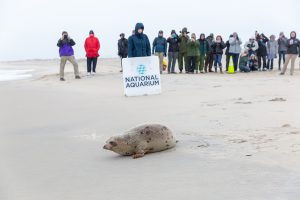
ASSATEAGUE — A female harp seal, rescued from the beach in Ocean City in January, was successfully released back into the wild on Friday from the beach at Assateague State Park.
The harp seal, known affectionately as Marie Tharp, was admitted on Jan. 29 to the National Aquarium’s animal care and rescue center in Baltimore. She was given a thorough examination, which revealed a variety of ailments and illnesses.
Over the last two months plus, Marie Tharp was treated with fluid therapy and antibiotics and was generally nursed back to health and full strength to the point she could be released back into the wild. That day came last Friday when the female harp seal was released from the beach at Assateague State Park. National Aquarium staffers opened Marie Tharp’s crate on the beach and the harp seal wandered out somewhat reluctantly before bounding into the ocean.
Marie Tharp was last seen with her head bobbing in the ocean just off the Assateague shoreline. She was equipped with a tag on her flipper so National Aquarium staffers can track her progress if she pops up again.
Every rescue season, the National Aquarium chooses a theme to name the various seals and other marine animals that come through its rehabilitation facilities and for this season, the theme chosen is influential scientists. To that end, the female harp seal rescued in Ocean City was named Marie Tharp, a famed cartographer and geologist who created the first scientific map of the Atlantic Ocean.
Tharp’s discovery of the Mid-Atlantic Ridge, a 10,000-mile-long valley in the sea floor, showed the ocean’s floor was spreading and creating new crust. That finding eventually led to the confirmation of continental drift, or what is now known as plate tectonics.
Each winter, migrating seals of various species and sizes pass through the mid-Atlantic region as part of their normal migratory patterns and more than a few haul out on the beaches in and around Ocean City and Assateague.
Many are simply resting or sunning themselves along their journey, while others are ill or injured, as was the case with Marie Tharp. In either case, the seals present an adorable opportunity for residents and visitors to enjoy them from afar, but interaction with humans and even their pets can often have dangerous consequences. To that end, the MCBP and the National Aquarium Marine Rescue Program on an outreach program for responsible seal viewing and sighting reporting.
Anyone who encounters a seal on the beach this winter is urged to call MARP’s direct line at 410-576-3880 so a trained observer can evaluate the condition of the animal to determine if it is just doing its normal activity or if it is in distress. Seal sightings can also be registered on the MCBP website at www.mdcoastalbays.org

